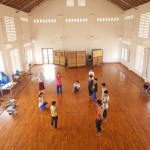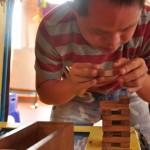(Pari Project Guest Post) Can you be both ‘unsustainable’ and great?
This is a guest post by Allie Hoffman of The Pari Project. She asked to share a reflection she had written about one of Pari’s clients, Epic Arts.
—-
I’m lucky that one of my favorite clients also happens to be one of my favorite people. Our friend Hannah started volunteering at a small disability arts organization called Epic Arts six years ago. Today, she’s the managing director and has been running the show for a few years.
In Cambodia, having a disability carries a double stigma; it is thought to be a result of your karma. Families often  shut their children away. If those children are hearing impaired or blind, they are rarely given a medium for communication unlike Chicago, where I grew up, where we have hearing aids, braille and sign language. Many times parents give up early on their children ever being ‘normal’.
shut their children away. If those children are hearing impaired or blind, they are rarely given a medium for communication unlike Chicago, where I grew up, where we have hearing aids, braille and sign language. Many times parents give up early on their children ever being ‘normal’.
Epic Arts uses the arts as a way to connect to the students. But it’s not your average finger painting/pipe cleaner curriculum. Last year, they hosted a highly acclaimed modern dance choreographer from Japan, who worked with the dance students on a contemporary dance piece called ‘4D’; the deaf dancers couldn’t hear the notes, but they knew the music. And they performed it beautifully in Trafalgar Square.
 The grounds in Kampot have been custom designed by a British architect; the floors are ‘sprung’ so that students can safely learn circus, break dancing, aerobatics, and yoga. The arts room hosts puppet making on a grand scale; life-sized cars, houses, and paper mache people line the walls.
The grounds in Kampot have been custom designed by a British architect; the floors are ‘sprung’ so that students can safely learn circus, break dancing, aerobatics, and yoga. The arts room hosts puppet making on a grand scale; life-sized cars, houses, and paper mache people line the walls.
All this is very expensive compared to more basic arts programs. You could never argue the work is ‘sustainable’. The staff to student ratio is extraordinarily high. They invest a lot of money in capacity building for their staff, many of whom have disabilities themselves. Per student spending is in the thousands of dollars per year – in Cambodia, where the average person makes approximately $500/year. If you ask Charity Navigator, they’d be a ‘one star’ charity cause they spend a lot on admin and overhead salaries. The total cost to build the Arts Center could have provided homes to 100 families.
But Epic Arts always a special magic – everyone who visits there says its so – and I’ve always wondered where it came from.
Han was in the office today, and I asked her what ‘believing in better’ meant to her. She spoke repeatedly about wanting to achieve the ‘best’ for her students. It doesn’t matter that we’re in Cambodia. It doesn’t matter that the ‘beneficiaries’ are disabled. It doesn’t matter that many of their parents don’t think it’s worth the time investment. It doesn’t matter that donors don’t GET why the number served looks low.
Han doesn’t have any false notions of saving these students, or curing them or healing them. She just wants to provide them the same opportunities a student in London, Hong Kong or New York would have. It’s not just that she invests time in the students; it’s that they are on a relentless quest to create a new future for them. They’re pushing themselves constantly – the next performance, the next exhibition, the next global tour – cause in doing so, they’re showing the staff & students what it means to push yourself into greatness.
Epic Arts isn’t easy to fundraise for; I should know, because we’ve been doing it for nearly 2 years now. It breaks with traditional measurements for effectiveness and impact, and challenges us to reconfigure. Epic Arts highlights the importance of flexibility, figuring it out as you go, and making a deep commitment to those you ‘serve’. Though Hannah would never say she serves. She’d say she just delivers the best.
———–
This is a guest post by Allie Hoffman of The Parivartan Project. Pari is a social enterprise that provides fundraising, marketing and organizational development services to grassroots development organizations that ‘believe in better’. To learn more: www.thepariproject.com
I (Daniela) have served on an informal advisory board for Epic Arts for the past year, and I too have been witness to the impact Epic Arts has had on the lives of both their staff as well as the students who are able to go through their programs. In reading through Allie’s reflection above, I pictured a class I had been able to sit in on recently at Epic where young teenage deaf students had been invited to a workshop series using movement and dance to teach sign language. It was beautiful to see students communicating with each other using sign language for the first time when most of them had gone through more than 10 years of their lives with no formal language. Allie’s piece brings to light the disconnect in how we often value NGOs. Is it the overhead to program ratio that matters more, or the impact the group is having? And how do you value that impact vs. the alternatives? Feel free to share your thoughts below.
